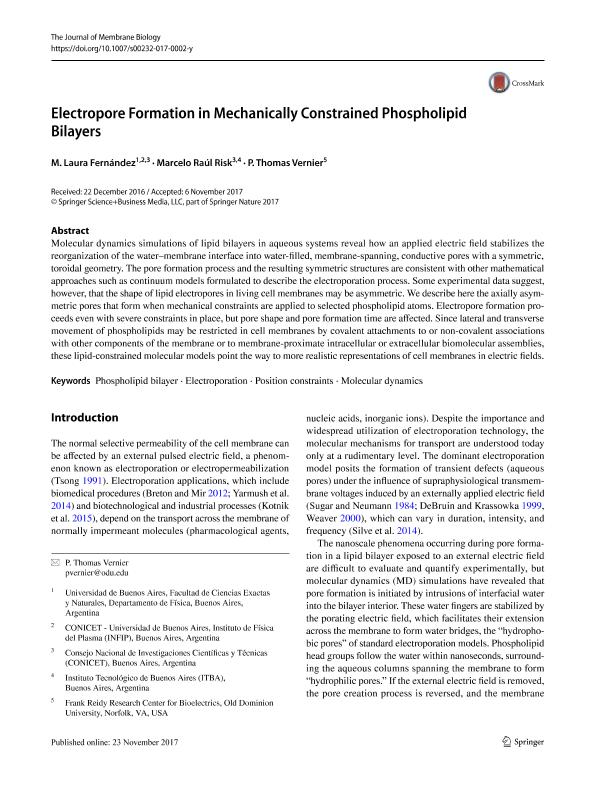Mostrar el registro sencillo del ítem
dc.contributor.author
Fernández, María Laura

dc.contributor.author
Risk, Marcelo Raúl
dc.contributor.author
Vernier, P. Thomas
dc.date.available
2018-08-30T14:14:31Z
dc.date.issued
2017-11
dc.identifier.citation
Fernández, María Laura; Risk, Marcelo Raúl; Vernier, P. Thomas; Electropore Formation in Mechanically Constrained Phospholipid Bilayers; Springer; Journal of Membrane Biology; 251; 2; 11-2017; 237-245
dc.identifier.issn
0022-2631
dc.identifier.uri
http://hdl.handle.net/11336/57647
dc.description.abstract
Molecular dynamics simulations of lipid bilayers in aqueous systems reveal how an applied electric field stabilizes the reorganization of the water–membrane interface into water-filled, membrane-spanning, conductive pores with a symmetric, toroidal geometry. The pore formation process and the resulting symmetric structures are consistent with other mathematical approaches such as continuum models formulated to describe the electroporation process. Some experimental data suggest, however, that the shape of lipid electropores in living cell membranes may be asymmetric. We describe here the axially asymmetric pores that form when mechanical constraints are applied to selected phospholipid atoms. Electropore formation proceeds even with severe constraints in place, but pore shape and pore formation time are affected. Since lateral and transverse movement of phospholipids may be restricted in cell membranes by covalent attachments to or non-covalent associations with other components of the membrane or to membrane-proximate intracellular or extracellular biomolecular assemblies, these lipid-constrained molecular models point the way to more realistic representations of cell membranes in electric fields.
dc.format
application/pdf
dc.language.iso
eng
dc.publisher
Springer

dc.rights
info:eu-repo/semantics/openAccess
dc.rights.uri
https://creativecommons.org/licenses/by-nc-sa/2.5/ar/
dc.subject
Electroporation
dc.subject
Molecular Dynamics
dc.subject
Phospholipid Bilayer
dc.subject
Position Constraints
dc.subject.classification
Inmunología

dc.subject.classification
Medicina Básica

dc.subject.classification
CIENCIAS MÉDICAS Y DE LA SALUD

dc.subject.classification
Ciencias de la Computación

dc.subject.classification
Ciencias de la Computación e Información

dc.subject.classification
CIENCIAS NATURALES Y EXACTAS

dc.title
Electropore Formation in Mechanically Constrained Phospholipid Bilayers
dc.type
info:eu-repo/semantics/article
dc.type
info:ar-repo/semantics/artículo
dc.type
info:eu-repo/semantics/publishedVersion
dc.date.updated
2018-08-28T13:35:54Z
dc.journal.volume
251
dc.journal.number
2
dc.journal.pagination
237-245
dc.journal.pais
Alemania

dc.journal.ciudad
Berlin
dc.description.fil
Fil: Fernández, María Laura. Consejo Nacional de Investigaciones Científicas y Técnicas. Oficina de Coordinación Administrativa Ciudad Universitaria. Instituto de Física del Plasma. Universidad de Buenos Aires. Facultad de Ciencias Exactas y Naturales. Instituto de Física del Plasma; Argentina
dc.description.fil
Fil: Risk, Marcelo Raúl. Instituto Tecnológico de Buenos Aires; Argentina
dc.description.fil
Fil: Vernier, P. Thomas. Frank Reidy Research Center For Bioelectrics, Old Domin; Estados Unidos
dc.journal.title
Journal of Membrane Biology

dc.relation.alternativeid
info:eu-repo/semantics/altIdentifier/url/http://link.springer.com/10.1007/s00232-017-0002-y
dc.relation.alternativeid
info:eu-repo/semantics/altIdentifier/doi/http://dx.doi.org/10.1007/s00232-017-0002-y
Archivos asociados
